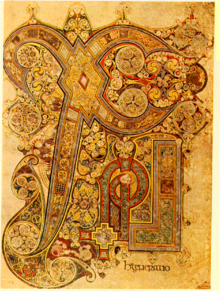Nomina sacra

Nomina sacra (singular: noun sacrum ) means in Latin "holy name" and is used as paläografischer technical term used for the tradition, several common ones holy names, titles or names in the early Greek Scriptures and in theological literature abbreviated to write.
The technical term Nomina sacra was coined by Ludwig Traube , using a term that he had found in the Carolingian exegete Christian von Stablo . In contrast to the secular and non-Christian writing, where suspension abbreviations predominated, contraction abbreviations were preferred for nouns sacra from the beginning. The contractions were indicated by an overline . Traube's presumed derivation of the phenomenon from the use of script in Hellenistic Judaism , to use the symbols ΘΣ and ΚΣ instead of the inexpressible tetragram YHWH , is no longer upheld, but “a very first suggestion by the tetragram in Jewish-Christian circles, such as Alexandria , seems possible. "
Christian inscriptions and initials

Nomina Sacra can be found in some of the oldest New Testament manuscripts e.g. B. in Papyrus 66 . The abbreviations used can provide information on the palaeographic age determination. At the beginning of the third century, the noun sacra in Christian inscriptions were sometimes shortened. This led to a sequence of Greek letters such as IH (Iota-Eta), IC (Iota-Sigma), or IHC (Iota-Eta-Sigma) for Jesus ( Greek Iēsous ) as well as XC (Chi-Sigma), XP (Chi-Rho ) and XPC (Chi-Rho-Sigma) for Christ (Greek Christos ). Here "C" stands for the uncial lunar ("moon-like") form of the Greek sigma ( lunar sigma ). This practice was adopted early on in the Latin-speaking West, partly while retaining Greek, partly using Latin characters, and partly mixed alphabets. For example, the Greek C (Sigma) could be transcribed into the Latin alphabet according to its sound, which then resulted in IHS and XPS. DS ( Deus ), DNS ( Dominus ), PR ( pater ), SPS ( spiritus ), SCS ( sanctus ) NR ( noster ) INRI ( Iesus Nazarenus rex Iudaeorum ), later also OMPS and OPS ( omnipotens ) were presented in purely Latin . The Greek and Latin declension endings could also be represented by replacing the last letter accordingly (DNI, DNM for Domini, Dominum , etc.). Related phenomena are the monograms and the abbreviated or initialized initial words at the beginning of sections within liturgical manuscripts and Bible manuscripts, which were often artistically designed and interpreted meaningfully using initials , e.g. B. TI ( Te igitur ) at the beginning of the Canon Missae , VD ( vere dignum ) at the beginning of the preface , B ( beatus vir ) at the beginning of the Psalter , LI or LIB (liber generationis) at the beginning of the Gospel of Matthew , XPI (Christi autem generatio ) at the beginning of the family tree of Jesus in the Gospel of Matthew (Mt 1:18); IN ( initium evangelii ) at the beginning of the Gospel of Mark , Q ( quoniam quidem ) at the beginning of the Gospel of Luke , INP (in principio) at the beginning of the Gospel of John .
The tradition of the noun sacra can also be found in Coptic , Armenian , Gothic and Church Slavonic manuscripts (see Titlo ).
List of Greek nouns sacra
| German meaning |
Greek word |
transcription | Nominative | Genitive |
|---|---|---|---|---|
| God | Θεός | Theos | ΘΣ | ΘΥ |
| Mr | Κύριος | Kȳrios | ΚΣ | ΚΥ |
| Jesus | Ἰησοῦς | Iēsous | ΙΣ | ΙΥ |
| Christ | Χριστός | Christos | ΧΣ | ΧΥ |
| son | Υἱός | Hyios | ΥΣ | ΥΥ |
| ghost | Πνεῦμα | Pneuma | ΠΝΑ | ΠΝΣ |
| David | Δαυίδ | Dauid | ΔΑΔ | |
| cross | Σταυρός | Stauros | ΣΤΣ | ΣΤΥ |
| mother | Μήτηρ | Meter | ΜΗΡ | ΜΗΣ |
| father | Πατήρ | Patēr | ΠΗΡ | ΠΡΣ |
| Israel | Ἰσραήλ | Israel | ΙΗΛ | |
| savior | Σωτήρ | Sōtēr | ΣΗΡ | ΣΡΣ |
| human | Ἄνθρωπος | Anthrōpos | ΑΝΟΣ | ΑΝΟΥ |
| Jerusalem | Ἰερουσαλήμ | Ierousalēm | ΙΛΗΜ | |
| sky | Οὐρανός | Ouranos | ΟΥΝΟΣ | ΟΥΝΟΥ |
| Theotokos | Θεοτόκος | Theotokos | ΘΚΟΥ |
See also
Individual evidence
- ↑ Walter Berschin : Is there a Middle Latin method? ( Memento of the original from August 27, 2014 in the Internet Archive ) Info: The archive link was inserted automatically and has not yet been checked. Please check the original and archive link according to the instructions and then remove this notice. (PDF file; 894 kB)
- ↑ Bernhard Bischoff: Paläographie (see literature below) p. 195.
- ^ David Trobisch : The final editing of the New Testament , NTOA 31 (Goettinge 1996), 16-31
literature
- Ludwig Traube : Nomina sacra. Attempt of a history of the Christian shortening (sources and studies on the Latin philology of the Middle Ages 2). Beck, Munich 1907. Unchanged. reprogr. Nachdr. Wissenschaftliche Buchgesellschaft, Darmstadt 1967.
- Otto Pächt : Illumination of the Middle Ages. An introduction . Prestel, Munich 1984. ISBN 3-7913-0668-5
- Bernhard Bischoff : Palaeography of Antiquity and the Occidental Middle Ages (Basics of German Studies 24). Erich Schmidt, Berlin 1979, fourth revised edition with a selected bibliography 1986–2008 by Walter Koch, 2009. ISBN 978-3-503-09884-2
- Bruce Butcher. Manuscripts of the Greek Bible. 1981.
- Philip Comfort and David Barett: Text of the Earliest New Testament Greek Manuscripts. 1999.
- AHRE Paap: Nomina Sacra in the Greek Papyri of the First Five Centuries. Papyrologica Lugduno-Batava VIII. Leiden 1959.
- Ph. Comfort: Encountering the Manuscripts: An Introduction to New Testament Paleography and Textual Criticism. Broadman & Holman Publishers 2005, pp. 199-253.
- Larry W. Hurtado: The Earliest Christian Artifacts: Manuscripts and Christian Origins. Cambridge 2006, pp. 95-134.
Web links
- The nomina sacra as part of the medieval abbreviation systems of the University of Bamberg, accessed on August 23, 2011
- Publications on Nomina sacra in the Opac of the Regesta Imperii
